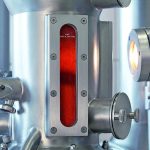For companies that manufacture and refine pigments, plant planning has to be underpinned by a clear plant design concept if investment and operational costs are to be kept manageable. The type of end product being manufactured will determine whether the production plant needs to conform to simple chemical industry standards or to more stringent hygiene standards. In this article, fluidised beds and spouted beds are used as examples to show how the interplay between hygienic equipment and the cleaning concept can ensure that the required level of product purity is achieved.
Pigments not only pep up our lives by adding colour, luminance, lustre and sheen; they are also of major economic significance. It is the inorganic effect pigment titanium dioxide that still makes British Racing Green such a sought-after colour today, almost ninety years after it first came to prominence in 1929. And without make-up and self-tanning lotions, which are manufactured with easily dispersible alkyl silanes, many models and actors would look rather pale in comparison. Even monetary stability benefits from forgery-proof banknotes containing pigment patterns with different magnetic coercivity values. High-performance pigments with previously unknown properties and particle sizes in the nanometre range are now opening up new opportunities for powder suppliers, plastics and paint manufacturers and for the automotive industry. Depending on the required quality of the end product, Glatt Ingenieurtechnik – the plant equipment manufacturer from Weimar, Germany – offers three different methods for refining pigments: fluidised bed technology, spouted bed technology and, since 2015, thermal powder synthesis for high-performance powders such as effect pigments. The fluidised bed and spouted bed techniques are particularly suitable for drying pigment suspensions, in order to produce particles with a precisely defined structure. Once the tendency to agglomerate has been removed, the pigment particles can then be coated in preparation for their actual intended use.
Regulations help keep colours clean
Any company that wants to set up a pigment processing plant will need to analyse and assess the risks associated with assuring product quality and purity as part of its quality management system. The resulting list of requirements compiled by that company can then be used to establish the engineering design concept at the start of the plant planning phase. This concept could, for example, include requirements to ensure compliance with GMP (Good Manufacturing Practice) or EHEDG (European Hygienic Engineering & Design Group) guidelines.
This is particularly relevant if the plant’s job is to process food additives or when a single plant is used to manufacture different products and there is a risk of cross contamination. Companies interested in getting food pigments to look tasty and inviting, or in adjusting the appearance of pharmaceutical products so that they enhance patient confidence, will need to conform with the relevant EHEDG and GMP guidelines. Ideally, the risk analysis carried out at the beginning of the plant design process will also include special requirements regarding measurement points, inspection and control options and any additional equipment such as safety systems or metal separators. If particularly toxic substances are to be processed, appropriate protection measures and containment concepts will need to be developed for both the production and cleaning processes. An efficient containment concept that conforms to FDA and ICH guidelines, as well as to the current EMA guidance that came into force on 1 June 2015, not only covers appropriate technical protection measures and personal protective equipment (PPE) to safeguard operating personnel but also includes an optimised maintenance and servicing strategy.
Factors affecting the cleaning process
The cleaning concept is an essential part of plant design and needs to be incorporated early on in the design process. For the purposes of configuring a suitable cleaning system, it is initially irrelevant whether the plant will be using fluidised bed or spouted bed technology. Whether or not there is any risk of cross-contamination as a result of, for instance, frequent product changes, and the methods that will be used to verify cleaning quality are more decisive considerations. What kind of cleaning agents should be chosen? Which mechanical forces are required in order to wash out any insoluble pigment residues? Plant owners, and more importantly plant operating personnel, should therefore be acquainted with the six factors affecting cleaning processes. The first factors to consider are those associated with the physical plant components, the design of connection points, the materials being processed and the roughness of plant components in contact with the products. The second set of factors influencing cleaning are the physical state, type and amount of contamination present. The cleaning procedure is then determined by four other factors, namely time, temperature, mechanical force and chemical concentration in combination with the cleaning media used (water, steam and alkaline, acid or industrial cleaner).
Wash-in-place – keeping it all inside
In the fine chemicals sector, the trend is towards the use of continuous fluidised bed systems that are able to produce particles with the same, consistent size and quality.
Spray drying and surface modification of the pigments using coating techniques can be carried out within the same process. In the case of a single-product plant with no particular associated hazard, manual dry or wet cleaning of the plant may be sufficient. However, whenever there are frequent changes of product (e.g. to produce seasonal colours or special editions), the cleaning effort required increases accordingly. In plants with frequent product changes, or where potentially hazardous products are processed, the recommended approach is to include an automated and enclosed wash-in-place (WIP) system.
Filters play a key role
The largest surface to be cleaned in the plant is the surface area of the filter elements. These elements are blown clean in situ with compressed air and the dust is reintroduced directly into the production process without loss. However, simply blowing off the dust from the surface of the filters proves inadequate if complete cleaning is necessary. Multipurpose plants for insoluble products are often equipped with baghouses containing filter tubes up to 5 m in length, which are made from a woven or nonwoven fabric. These are the most cost-effective type of filter and they can be washed either within the plant itself or in a washing machine. For smaller plants, the best solution is often to use filter cartridges up to a metre in length that provide a filter surface area of between 3 and 5 m2.
Smaller size, higher performance
Plate filters are recommended for plants that process pigments continuously. For a number of years now, a space-saving solution has been available in which the plate filters can be removed sideways from the fluidised or spouted bed apparatus. The latest generation of filters for Glatt’s fluidised and spouted bed systems are now even smaller in size while at the same time delivering better performance and a longer service life.
Although these new systems use fewer and more compact filter elements – a single filter element is just 80 cm long – they show the same or, in some cases, improved filter performance. In order to be cleaned, plate filters and filter cartridges need to be removed from the clean gas side of the filter unit. The advantage of external cleaning is that cross-contamination can be definitely ruled out. That is particularly important in the field of pigment design, as it is the only way to ensure that sticky, insoluble particles or gel-like deposits are completely eliminated. To be absolutely certain of avoiding cross-contamination, separate sets of filters can be assigned to individual products or product families. An integrated approach to the layout of the work rooms and processing zones determines how filters are transported to the washing station, how they are dried and stored and whether or not pass-through chambers for transferring materials or airlocks for human passage are required.
Fluidised and spouted bed technologies are among the most advanced methodologies for carefully tailoring or optimising product properties. A thorough plant planning phase helps to keep investment costs within budget. A well-designed cleaning system, an intelligent layout of workspaces and zones for washing and dry storage of the filter elements, a tried-and-trusted inspection concept and an optimised filter system combine to ensure that the purity of industrially manufactured pigment products fully meets chemical industry standards as well as the even stricter hygiene design standards, while at the same time lowering total costs. A systematic and well-planned maintenance and servicing strategy guarantees operational reliability over many years.
www.cpp-net.com search: cpp0217glatt
Frank Ohlendorf
Planning and Engineering Design, Process Technology Food, Feed & Fine Chemicals,
Glatt Ingenieurtechnik
Share:









